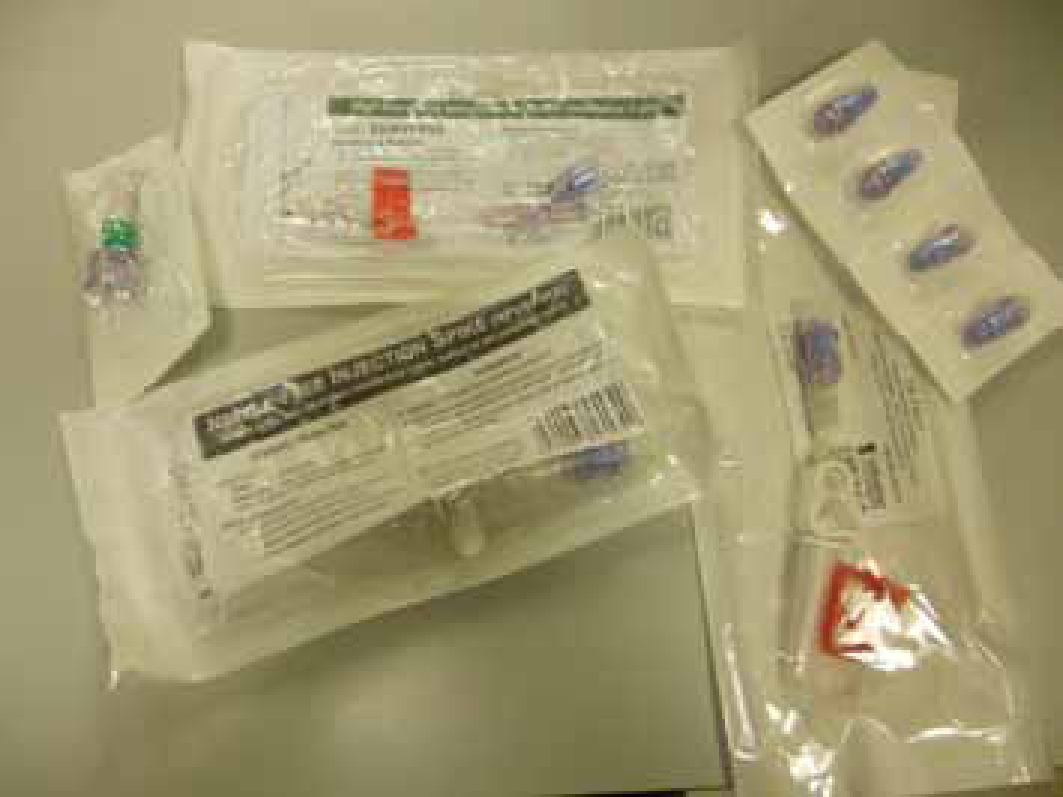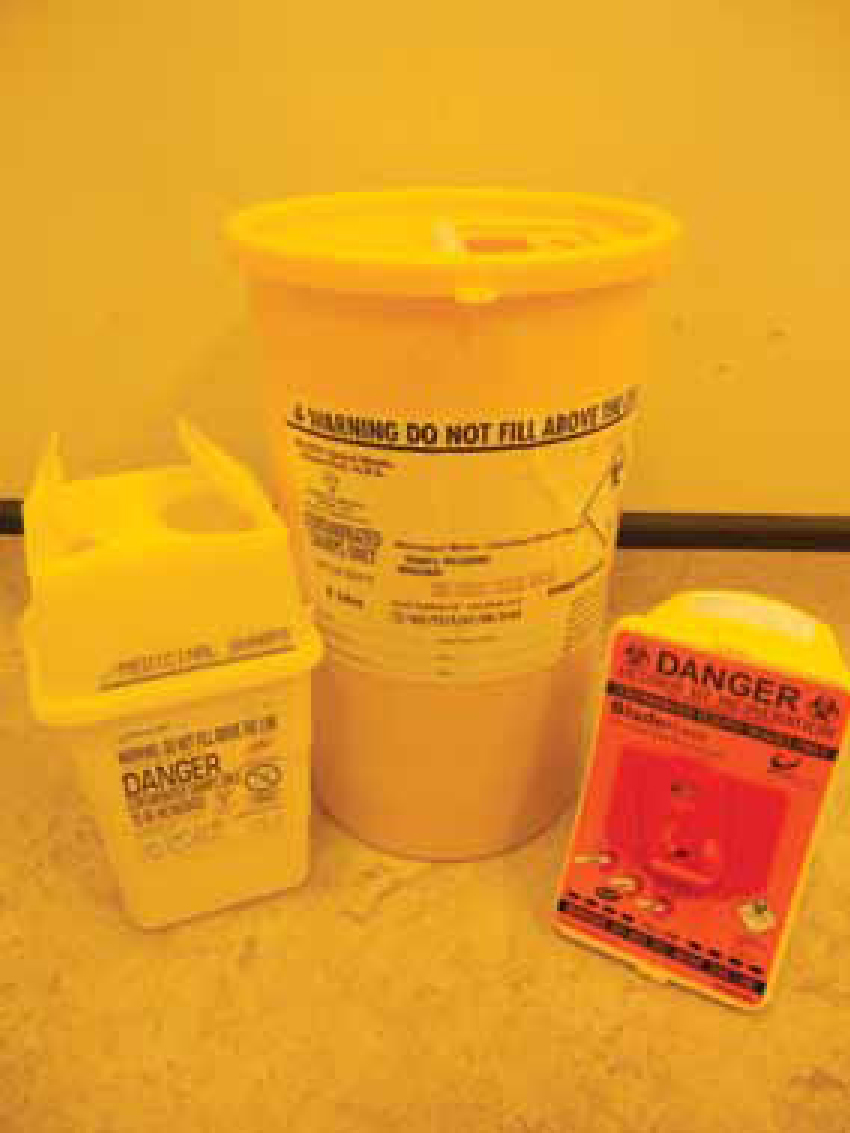
The handling of sharp objects in veterinary practice is common procedure; veterinarians and veterinary nurses are required to administer injections, place catheters and take blood samples. Surgical procedures are performed using blades and sharp instruments; many consumable materials are of hard plastics, which also have the potential to cause injury. Thus all uses of sharps need to be approached in a mature and responsible manner (Department of Health, 2013; Health and Safety Executive (HSE), 2013a).
In practice, a common term for percutaneous injury is ‘needle-stick injury’. A needle-stick injury or sharps injury is when the sharp item penetrates the skin. Anxiety and concerns about adverse effects are at the forefront as a result of skin penetration and the potential exposure to infectious disease agents from the sharps (Horsburgh and Mahon, 2008), especially if the sharps are contaminated with medicines or blood.
In human hospitals the risk of blood-borne viral pathogens (such as hepatitis B virus, hepatitis C virus and human immunodeficiency virus) has played a crucial part in European Union (EU) Council Directives, including the Directive 2010/32/EU on the prevention of sharps injuries in the hospital and healthcare sector (European Agency for Safety and Health at Work, 2010). To protect healthcare workers, the EU Council Directive added some additional requirements to health and safety legislation (Health and Safety Executive, 2013b; NHS European Office, 2013); this is currently enforced for NHS and private clinics, occupational health services and nursing homes. The protocols and supportive information outlined in this article are taken from this legislation (Health and Safety Executive, 2013b).
Although healthcare workers are legally bound by the Directive 2010/32/EU, there are no reasons as to why the veterinary profession cannot follow these guidelines under clinical governance (Royal College of Veterinary Surgeons, 2012).
Safer sharps
Safety concerns are often thought of as costly; it is important to evaluate the current circumstance within the veterinary environment and apply safety measures to the areas of most concern as necessary. A safety survey checklist around the practice is practicable, and it is important to record sharps injuries within the practice. A report will identify the areas with high sharps injuries, such as theatre, wards or consulting room, and whether these injuries occur prior to, during or after the procedure. The report will help towards choosing the most appropriate safety device for the practice.
Derived mainly from the human market there are now many items that can be used in place of sharps; where some sharps cannot be ruled out altogether, there are safety mechanisms available.
The following safety devices are useful in veterinary practice and should be considered:
Disposal of sharps
Dispose of sharps at the point of use; do not put them in pockets or on the side for someone else to pick up. Small containers can be placed near to workstations (Figure 2).

All sharps must be disposed of in appropriate containers that comply with the BS EN ISO 23907:2012: specification for sharps containers (British Standard Institution, 2012). Contaminated sharps have the potential risk of passing on infection, and must be disposed of in yellow sharps containers with yellow lids, which should be incinerated under the European Waste Catalogue EWC 180202 (Environmental Protection Agency, 2002). Sharps not contaminated by medicines can be disposed of in yellow containers with orange lids under the EWC 180202 (Environmental Protection Agency, 2002). Cytotoxic and cytostatic sharps waste must be disposed of in purple-top sharps bins; this waste is managed separately and falls under the EWC 180202 (Environmental Protection Agency, 2002).
Table 1 summarises good practice guidelines that should be implemented in veterinary practices to reduce injuries from sharps, and protocols to follow in case of injury.
| Protocol | Further information |
|---|---|
| Risk assessments | Document the risks of sharps. Inform staff of where documents are kept for reference |
| Training | Provide training on how to use sharps and alternative safer sharps devices (Health and Safety Executive [HSE], 2013b, regulations 6(2),(3) and (4)) |
| Avoid unnecessary use of sharps | Employer should ensure sharps are only used where they are required (HSE, 2013b, regulation 5(1)(a)) |
| Use safer sharps | Where reasonably practicable to do so (HSE, 2013b, regulation 5(1)(b)) |
| Prevent the resheathing of hypodermic needles | Applied if reasonably practicable to do so. Use needle recapping devices or scoop method to recap (HSE, 2013b, regulation 5(1)(c)) |
| Safe disposal and secure containers | Provide instructions on safe disposal and secure containers of sharps (HSE, 2013b, regulations 5(1)(d) and 7(6)(c)) |
| Sharps injury | Provide protocols for employees to follow in the event of sharps injuries (HSE, 2013b, regulation 8) |
| Record and investigate | Record and investigate injuries and take appropriate action. Immediate access to medical advice and counselling may be required (HSE, 2013b, regulations 7(1) and (2)) |
| Review procedures and processes | Regularly review procedures and processes (HSE, 2013b, regulation 5(2)) |
| Employees must: | |
| Sharps-related injury | Employees must notify their employer of any sharps-related injury. The employer should have a protocol in place on how to report a sharps injury and procedures to follow for care purposes |
Conclusion
The use of sharps in the veterinary environment is essential to practice, although as identified in this article, there are safer sharp consumables available and with the justification from risk assessments these consumables will be of benefit to employees and patients to reduce sharps injuries. Producing clear guidelines for employees to follow and having documented reporting procedures of injuries in place are an important measure in collecting data. The regulations in place are for the protection of healthcare workers and it would be justifiable for veterinary related workers to adopt the same principles for employees' own safety and patient welfare.
